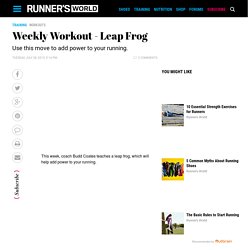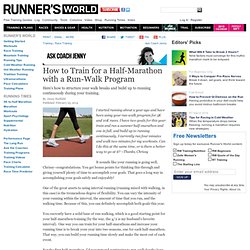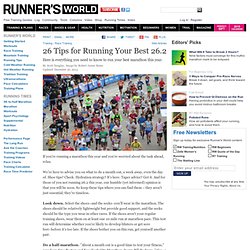

Weekly Workout - Hopscotch. Welcome back, {* welcomeName *}!

{* loginWidget *} Welcome back! {* #signInForm *} {* signInEmailAddress *} {* currentPassword *} {* /signInForm *} Your account has been deactivated. Please confirm the information below before signing in. {* #socialRegistrationForm *} {* emailAddress *} {* displayName *} Runner's World Newsletters {* /socialRegistrationForm *} Please confirm the information below before signing in. {* #registrationForm *} {* emailAddress *} {* displayName *} {* newPassword *} {* newPasswordConfirm *} {* /registrationForm *}
Weekly Workout - Leap Frog. Welcome back, {* welcomeName *}!

{* loginWidget *} Welcome back! {* #signInForm *} {* signInEmailAddress *} {* currentPassword *}
Lolo Jones' Core Workout. A generation ago, you'd be hard-pressed to find elite runners paying attention to their abs.

Today, it's practically mandatory. "Our coaches drill the importance of core conditioning into our heads," says world champion hurdler Lolo Jones. "We're at it all the time. " That's because scientists and coaches now know that you can't run your best without a strong core, the muscles in your abdominals, lower back, and glutes. They provide the stability, power, and endurance that runners need for powering up hills, sprinting to the finish, and maintaining efficient form mile after mile.
"When your core is strong, everything else will follow," says Greg McMillan, a running coach in Flagstaff, Arizona, who has worked with scores of elite and recreational runners. 10 Essential Strength Exercises for Runners. We asked our experts to come up with 10 essential strength exercises for runners.

Worried about fitting this routine into your training schedule? Don’t worry, these 10 exercises take 30 minutes to complete and can be done twice a week. Jump In... to Cross-Training. Sometimes, it's what you do when you're not running that can give your training an edge.

That's the case with cross-training. A weekly nonrunning workout gives your muscles and joints a break from pounding the pavement while producing specific benefits that carry over to your running. "If you only run, you're essentially using the same muscles within the same plane of motion over and over again," says Shannon Colavecchio, CEO of Badass Fitness in Tallahassee, Florida, who trains runners in cycling, rowing, and core-strengthening classes. Running on "E" It's an indisputable fact that to run far and fast, you need to start out fully fueled.

How to Train for a Half-Marathon with a Run-Walk Program. I started running about a year ago and have been using your run-walk program for 5K and 10K races.

I have two goals for this year: train and run a summer half-marathon and one in fall, and build up to running continuously. I currently run four minutes and walk two minutes for my workouts. Can I do this at the same time, or is there a better way to go at it? ~Thanks, Chrissy. 26 Tips for Your Best Marathon. If you're running a marathon this year and you're worried about the task ahead, relax.

We're here to advise you on what to do a month out, a week away, even the day of. Shoe tips? Check. Standing Core Workout. Not So Fast. Runners are often focused on moving faster.

But when it comes to strength training, slowing down can be beneficial. There are three ways to work a muscle: isometric (no movement), concentric (contracting the muscle), and eccentric (releasing the muscle). Eccentric strength training involves slowing down the release of a muscle, which puts the muscle under a different kind of stress. By challenging the muscles in this way, they get stronger and become more resistant to damage, says Juan Gonzalez, Ph.D., C.S.C.S., C.P.T., an assistant professor in the Department of Health & Kinesiology at the University of Texas—Pan American. As you do the following exercises, pay attention to pacing: One part of the movement should be done slowly. 1. Not So Fast. How To Run Your Best Marathon Pace—Guaranteed. Every time I look at the data from a recent study of marathon pacing, I see the same thing: blinking red lights.

The study is trying to tell us something—something much more important, I believe, than the obvious fact that marathon-running is tough on the leg muscles. Newswire first reported the study here; you can find the free full text here. Here’s what I found strange and informative about the study. Does Stretching "Loosen" Muscles and Tendons?
There's plenty of debate about whether stretching before and/or after running is useful. But we spend less time thinking about what stretching actually does – what's changing on a muscular, neuromuscular, and biomechanical level when we stretch. A recent study in the Journal of Applied Physiology, from an international team of researchers in Australia, the U.S., the U.K., and Denmark, takes a very detailed look at the changes that follow a three-week program of twice-a-day static calf stretches (hat tip to muscle physiologist Jared Fletcher for pointing it out). The study is pretty complicated. They tried to measure pretty much every parameter they could think of – not just how range of motion changed, but how muscle and tendon properties changes, how electrical activity in the muscles change at different angles, how communication from the muscles to the spinal cord and brain changed, and so on.
But there are a couple of key messages. It's not quite that simple, though. So What Does "The Wall" Really Look Like? Note: This interactive chart will "stick" to the top of your screen as you read the article. Clicking the links in the article text will change the chart. If you run marathons or hang out with people who do, you've heard the phrase, "I hit the wall. " The imagery of a wall is stark and awful–a distinct point in a race in which the body no longer heeds the mind and race plans and dreams fall to pieces. All is well until–bam! Four Reasons For A Long Run Gone Wrong. Coach, I just finished perhaps the worst long run ever. I’m training for a marathon–my fifth–and covered 18 miles. But I had to stagger through the final few miles. My leg hurt, my breathing was labored, and it was as if I hadn’t been running all season. Run Your Best Doubles.
I thought running twice a day was hard enough—until I started training with coach Matt Centrowitz Sr. back in 2002. Every Thursday, his group ran a tempo in the a.m. and a track or hill workout in the p.m. "Super doubles" helped us practice running fast on tired legs. The demands are severe, but if you can nail this session, you'll have the confidence of knowing that when the going gets tough, you can stay on pace. Build Your Base Centro started me off with easy 20-minute morning runs two or three times a week on quality days that gradually built to 40 minutes. After six months, I got the green light for the tempo run. Run Tempo in the A.M. Hit Race Pace in the P.M. Hal Higdon Training Programs. Marathon Training Guide - Novice 2 HERE IS MY NOVICE 2 PROGRAM, a slight step upwards in difficulty from Novice 1. It is designed for people with some background as a runner, whether or not they have run a marathon before. Runners differ greatly in ability, but ideally before starting a marathon program, you should have been running about a year.
You should be able to comfortably run distances between 3 and 6 miles. You should be training 3-5 days a week, averaging 15-25 miles a week. Novice 2 is nearly identical to Novice 1, but there are some differences, mainly: 1) You do pace runs on Wednesdays, and 2) the mileage is somewhat higher. Long runs: The key to the program is the long run on weekends, which builds from 8 miles in Week 1 to 20 miles in the climactic Week 15. 5 Core Workouts for Stronger Running. How Can I Recover from My Half or Full Marathon? Yoga Inversion Poses for Runners. The 100 Best Fitness Tips. 10 Mistakes to Avoid on Marathon Day. Overcoming Mental Blocks. Every runner has moments of doubt–and that's not always bad. Running for Time vs. Distance. Researchers have found that our minds process distance and time differently.
How to Prevent Marathon Fatigue. Three Simple Ways to Improve Running Efficiency. Three Workouts to Increase Pain Tolerance. Tying Your Shoes. 10 Mistakes to Avoid on Marathon Day. 9 of the Best Lower Abs Exercises. The Body Shop: Flex Benefits. Running Efficiently. Batman Workout!! Lolo Jones' Core Workout. Half Marathon Checklist. Regain Your Primal Speed with Sprint Workouts. Ab Exercises to Get a Six Pack. Pace Wristband Creator. Killer Kardio. 7 Surprising Sources of Running Injuries. Three Ways to Improve Your Marathon Finish Time. The Body Shop: Muscle Equity. Boss Drop Locations - Knights and Dragons Wiki. 8 Ways to Extend Your Long Run.
Running Tutorial. Running Tutorial. How to Improve Your Running Form: The 5 Biggest Mistakes Beginning Marathoners Make. Proper Running Technique: Running Form Tips and Drills. 20th Anniversary Walt Disney World Marathon Mickey Medal Reveal. MARATHON TRAINING // Marathon Day. 2012 Facebook Player (Single) Running in heat and intense humidity: How to do it safely. Jeff Galloway Run Disney Training Consultant. After the Marathon - Running. Running Quotes - Running Quotes from John Bingham.